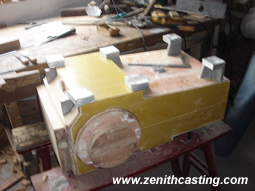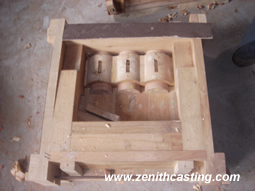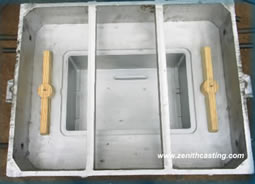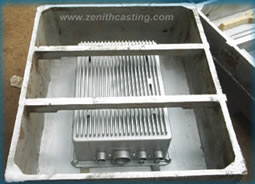Aluminum Sand casting mold design process
Aluminum sand casting is a process of pouring molten aluminum alloy into a mold cavity formed out of sand (natural or synthetic), and solidification in it. Thus, the process of aluminum sand casting mold design should care for patterns, sprues and runners, design consideration, and casting allowance.


Aluminum mold:
A pattern (an approximate duplicate of the real casting part) is used to form pouring sand cavity, which can be made out of wood, or metal. Zenith aluminum casting now applies aluminum patterns instead of wooden mold in order to achieve more accurate design details and longer service life. Then the formed cavity is contained in an aggregate housing in a box called the flask. A core is a sand shaped part inserted into the mold to produce the internal features of the part such as holes or internal passages. Cores are located or supported by core prints, which are the regions added to the pattern, core within the mold. A riser is an extra void created in the mold to contain excessive molten aluminum, so as to feed the molten aluminum alloy to the mold cavity as the molten aluminum solidifies and shrinks, and thereby to prevent voids in the main aluminum casting.


In a two-part aluminum sand casting mold, the upper half, including the top half of the pattern, flask, and core is called cope and the lower half is called drag. The cope and drag are separated by the parting line or the parting surface. The drag is first filled partially with sand, and the core print, the cores, and the gating system are placed near the parting line. The cope is then assembled to the drag, and the sand is poured on the cope half, covering the pattern, core and the gating system. Then a vibration is used mostly handwork means by zenith aluminum casting to compact the sand. Next, the cope is removed from the drag, and the pattern is carefully removed without breaking the mold cavity. Here drafts design is essential to facilitate the process, as a slight angular offset from the vertical to the vertical surfaces of the pattern can be helpful. However, the rougher the surface of the pattern, the more the draft to be provided.
Sprues and Runners
The molten aluminum is poured in the pouring cup, which is a part of the gating system that supplies the molten aluminum to the mold cavity. The vertical part of the gating system connected to the pouring cup is called the sprues, and the horizontal portion is called the runners and finally to the multiple points where it is introduced to the mold cavity called the gates. Additionally there are extensions to the gating system called vents that provide the path for the built up gases and the displaced air to vent to the atmosphere.
Casting allowance consideration
The cavity is usually made oversize to allow for the aluminum alloy contraction as it cools down to room temperature. This is achieved by making the pattern oversize. To account for shrinking, the pattern must be made oversize by these factors, on the average. These are linear factors and apply in each direction. These shrinkage allowances are only approximate, because the exact allowance is determined by the shape and size of the aluminum casting. In addition, aluminum sand castings generally have a rough surface sometimes with surface impurities, and surface variations. A machining (finish) allowance is necessarily made for this type of defect.
Quick Inquiry of Casting
For any question about aluminum or brass sand casting and gravity casting, please contact us directly via following means:
P:Ms.Elandy Chen
T:+86 574 8865 1898
E: sales@zenithcasting.com

